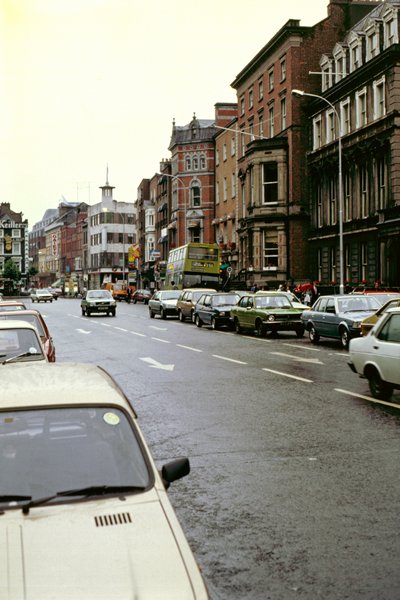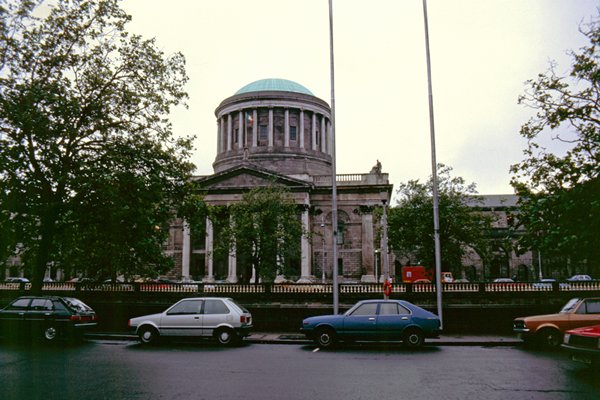
[28-7-1985]
Uit de reisbeschrijving van Frames National:
Travel from and to Dublin is by Dan Air service from Gatwick Airport and upon arrival at Dublin Airport the tour coach will be waiting to transfer to the Shelbourne Hotel. The remainder of the day is free.

[29-7-1985]
Foto: Four Courts, Dublin.
Uit de reisbeschrijving van Frames National:
Dublin, capital of the Republic and Ireland’s principal sea port, is a medium sized city, more at home as a quiet backwater than ¡n the role of the international metropolis. Spreadeagled around the mouth of the River Liffey at the head of Dublin Bay, it’s a city of broad, spacious streets and handsome squares laced together by the Grand Canal, a thin line of water circling the heart of the city. A salt-aired vigour is wafted in along the River Liffey, its banks lined with brown-walled wharves, and the spacious main streets have a freshness and lightness that make this one of the most exhilarating of European cities.
The ford over the River Liffey has been important since Celtic times, and there was a thriving Christian community here from the 5th C, following their conversion by St. Patrick in AD 448. In AD 840 the marauding Vikings landed here, built a fortress on the high ground and established a settlement along the banks of the estuary. Originally a base for their numerous raiding sorties, ¡t soon became a flourishing trading port as well converted to Christianity, the Vikings were finally driven out by the Anglo-Norman under Strongbow, who took Dublin by storm, executing the Viking leader, Hasculf. In 1172 Henry II, having established his feudal rights over the invading force, received the submission of the Irish chieftains on the site of College Green. He granted the city by charter to the men of Bristol, from whence the Anglo-Normans had originally come.
The inhabitants remained loyal to the English crown, supporting King Charles during the Civil Wars. Captured by the Parliamentarians in 1647, the city underwent a great architectural expansion following the Restoration of Charles II.
During the Williamite wars Dublin was a Jacobite stronghold. lt was here that James II held his last parliament in 1689. By the end of the 17th C, Dublin was already a flourishing commercial centre; public street lighting had been introduced in 1697 and during the following century the city was transformed into one of handsomest of Georgian cities. Now elegantly spacious streets and squares were planned and palatial town houses built. With government now in London, few of the noblemen required their fine mansions and many returned to their country estates or left for London.
In 1905 the Sinn Fein movement was formed, in 1909 the Irish Transport and General Workers Union was set up under the leadership of James Connolly, and in 1913 there was a massive strike, paralysing the city. In 1916 the Irish Volunteers seized the Post Office in Lower O’Connell Street as their headquarters and the Easter Rising had begun. It was quickly crushed but so brutally that public conscience, clearly appalled, overwhelmingly elected Sinn Fein at the general election of December 1918 with de Valera as the new president.
Whilst the Dublin faction were openly ¡n support of the guerilla bands operating across the country, the Ulster Unionists set up their own provisional government, and the ambushes and assassinations which characterised the Anglo-Irish War, featuring the notorious Black and Tans, began in bloody earnest. Despite the ratification of the Irish Free State in January 1922, a large and dissatisfied faction of leaders ¡n the Irish movement took up arms against their former comrades and seized the Four Courts, which they held for two months. The subsequent shelling ordered by the new Dublin Government destroyed much of O’Connell Street but by the 1930s most of the public buildings had been restored.
Dublin is compact and quite small for a capital city and its city centre extends for only a mile or so along O’Connell Street and Grafton Street on either side of the Liffey. The river flows from west to east across the city and is crossed by ten road bridges, two rail and one foot-bridge. Although no longer the focal point of the city, the O’Connell Bridge is a good central landmark from which to find one’s bearing. The city centre, a busy area with cramped, bustling streets is circled by the north and south circular roads. To the west is the 2,000 acre Phoenix Park and to the east is Dublin Bay. The harbour was begun in 1714 with the embanking of the River Liffey and the construction of the first of the three great sea-walls, the North Wall quay.
St Patrick’s Cathedral in Patrick Street is over 340 feet in length, the longest cathedral in Ireland. Like Christchurch, it is a fine example of Early English architecture, with a cruciform plan, simpler in detail, and marvellously spacious. The National Cathedral of the Church of Ireland, it was built between 1220-54 and was restored in the 19th C. There are several interesting tombs including that of Jonathan Swift, who was Dean here for 32 years. In the south transept is a door with a hole in it where the Earls of Ormond and Kildare finally shook hands in 1491, after years of conflict.
volgende: Dublin-Westport